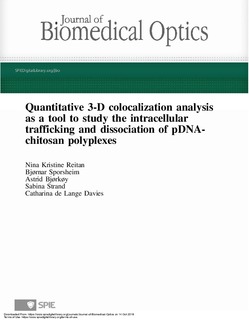| dc.contributor.author | Reitan, Nina Kristine | |
| dc.contributor.author | Sporsheim, Bjørnar | |
| dc.contributor.author | Bjørkøy, Astrid | |
| dc.contributor.author | Strand, Sabina P. | |
| dc.contributor.author | Davies, Catharina De Lange | |
| dc.date.accessioned | 2019-10-16T07:22:33Z | |
| dc.date.available | 2019-10-16T07:22:33Z | |
| dc.date.created | 2012-09-24T13:39:09Z | |
| dc.date.issued | 2012 | |
| dc.identifier.citation | Journal of Biomedical Optics. 2012, 17 (2), . | nb_NO |
| dc.identifier.issn | 1083-3668 | |
| dc.identifier.uri | http://hdl.handle.net/11250/2622424 | |
| dc.description.abstract | Multichannel microscopy is frequently used to study intermolecular interactions and spatial relationships between biomolecules and organelles or vesicles in cells. Based on multichannel images, quantitative colocalization analysis can provide valuable information about cellular internalization, vesicular transport, and the intracellular kinetics and location of biomolecules. However, such analyses should be performed carefully, because quantitative colocalization parameters have different interpretations and can be highly affected by image quality. We use quantitative three-dimensional colocalization analysis of deconvolved and chromatic-registered confocal images to study the dissociation of double-labeled pDNA-chitosan polyplexes in HeLa cells and their colocalization with early endosomes. Two chitosans that form polyplexes with highly different transfection efficacies are compared. Pearson's correlation coefficient, Manders' colocalization coefficients, and the intensity correlation quotient are estimated to determine the intracellular localization of polyplexes, free pDNA, and free chitosans. Differences are observed in the amount of uptake, and in the intracellular pathways and rates of dissociation for the two chitosans. The results support previous findings that polyplexes formed by self-branched, glycosylated chitosan oligomers are more favorable for cellular uptake and intracellular trafficking to the nucleus compared with polyplexes formed by linear chitosans. | nb_NO |
| dc.language.iso | eng | nb_NO |
| dc.publisher | Society of Photo-optical Instrumentation Engineers (SPIE) | nb_NO |
| dc.title | Quantitative 3-D colocalization analysis as a tool to study the intracellular trafficking and dissociation of pDNA-chitosan polyplexes | nb_NO |
| dc.type | Journal article | nb_NO |
| dc.type | Peer reviewed | nb_NO |
| dc.description.version | publishedVersion | nb_NO |
| dc.source.pagenumber | 12 | nb_NO |
| dc.source.volume | 17 | nb_NO |
| dc.source.journal | Journal of Biomedical Optics | nb_NO |
| dc.source.issue | 2 | nb_NO |
| dc.identifier.doi | 10.1117/1.JBO.17.2.026015 | |
| dc.identifier.cristin | 946112 | |
| dc.description.localcode | Open Acees article. Published by Society of Photo-optical Instrumentation Engineers (SPIE) 2012. | nb_NO |
| cristin.unitcode | 194,66,20,0 | |
| cristin.unitcode | 194,66,10,0 | |
| cristin.unitcode | 194,66,15,0 | |
| cristin.unitname | Institutt for fysikk | |
| cristin.unitname | Institutt for biologi | |
| cristin.unitname | Institutt for bioteknologi og matvitenskap | |
| cristin.ispublished | true | |
| cristin.fulltext | original | |
| cristin.qualitycode | 2 | |
